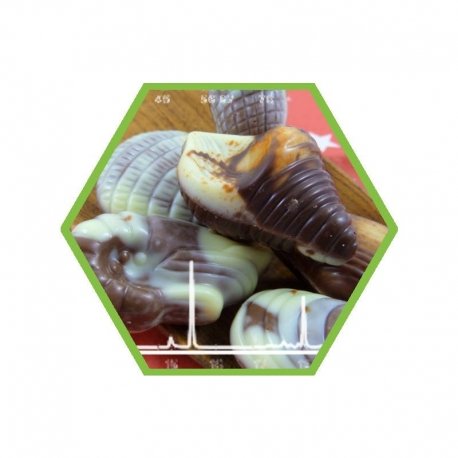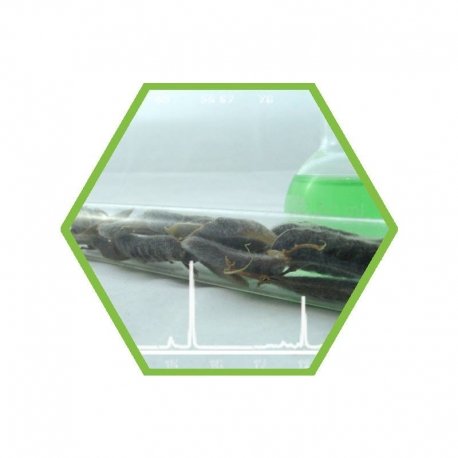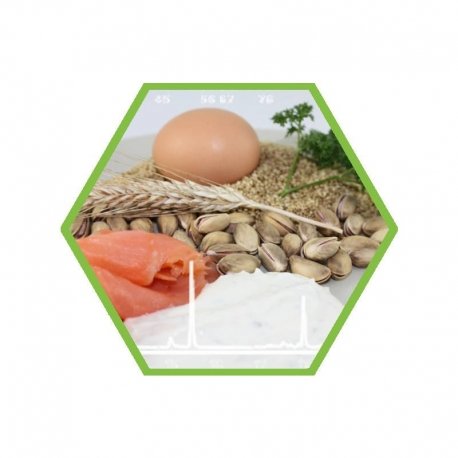{:de}
my-lab’s Service zur Allergenkennzeichnung und unsere Analysen zum Nachweis von Allgergenen finden Sie hier.
Die Zahl der Lebensmittelunverträglichkeiten steigt stetig an. Seit 2014 müssen 14 Produktgruppen auf Fertigpackungen, Menükarten und loser Ware gekennzeichnet werden. Die Kennzeichnung von Allergenen ist nicht nur rechtlich vorgeschrieben, sondern für Allergiker auch absolut notwendig.
Welche Allergene müssen gekennzeichnet werden?
Für Allergiker ist die Allergenkennzeichnung besonders wichtig. 14 Produktgruppen sind eindeutig als Allergene klassifiziert und müssen, sofern sie im Lebensmittel enthalten sind, gekennzeichnet werden durch beispielsweise “enthält Erdnüsse” und eine Hervorhebung dieser Zutat in der Zutatenliste (Fettdruck). Häufig begibt sich der Hersteller eines Produktes auf die sichere Seite und warnt beispielsweise “kann Spuren von Erdnuss enthalten”, obwohl Erdnüsse nicht als Zutat eingesetzt wurden. Er trägt damit möglichen Querkontaminationen, beispielsweise über die vorher auf der gleichen Linie gefertigten Lebensmittel, Rechnung.
Anzuzeigen sind die 14 wichtigsten allergenen Produktgruppen:
- glutenhaltiges Getreide ( Weizen (wie Dinkel und Khorasan-Weizen), Roggen, Gerste, Hafer oder Hybridstämme davon)
- Krebstiere
- Eier
- Fisch
- Erdnüsse
- Soja
- Milch (einschließlich Lactose)
- Schalenfrüchte (Mandeln, Haselnüsse, Walnüsse, Cashewnüsse, Pecannüsse, Paranüsse, Pistazien, Macadamia- oder Queenslandnüsse)
- Sellerie
- Senf
- Sesamsamen
- Schwefeldioxid und Sulfite (ab 10mg/kg bzw. L)
- Lupinen
- Weichtiere (Schnecken, Austern, etc.)
Zutaten, die aus diesen Produktgruppen stammen, sind in der Zutatenliste hervorzuheben.
Die Kennzeichnungspflicht gilt auch für alle allergen wirkenden Verarbeitungsprodukte der Allergene und für die bei der Produktion eingesetzten Hilfsstoffe.
Stoffe, die durch den Herstellungsprozess ihr allergenes Potential verlieren, müssen nicht gekennzeichnet werden. Die Ausnahmen werden im Anhang II der Verordnung (EU) Nr. 1169/2011 benannt.
Zu diesen Stoffen gehören zum Beispiel:
- Glukosesirup hergestellt auf Weizen- oder Gerstenbasis und auch Dextrose oder Maltodextrine auf Basis von Weizen,
- Getreide zur Herstellung von alkoholischen Destillaten einschließlich Ethylalkohol landwirtschaftlichen Ursprungs
- vollständig raffiniertes Sojabohnenfett und -öl,
- Fischgelatine oder Hausenblase, die als Klärhilfsmittel in Bier und Wein verwendet wird;
- Molke zur Herstellung von alkoholischen Destillaten einschließlich Ethylalkohol landwirtschaftlichen Ursprungs;
Hier können Sie die Infografik zu der Allergenkennzeichnung herunterladen.
Wie funktioniert die Kennzeichnung bei loser Ware und Menükarten im Restaurant?
Neu ist, dass auch bei unverpackter Ware (z. B. an der Bedienungstheke oder im Restaurant) eine Information über Allergene verpflichtend ist. Gibt es kein Zutatenverzeichnis, müssen die Stoffe oder Erzeugnisse mit dem zusätzlichen Hinweis “enthält” angegeben werden, zum Beispiel “enthält Erdnüsse”. Wenn sich die Bezeichnung des Lebensmittels eindeutig auf diese Stoffe oder Erzeugnisse bezieht, ist keine Angabe erforderlich. (z.B. Hähnchen in Erdnusssoße muss nicht mit “enthält Erdnüsse” gekennzeichnet werden.)
An der Bedienungstheke kann diese Information schriftlich, elektronisch oder mündlich erfolgen. In der Verkaufsstätte muss es einen deutlichen Hinweis an gut sichtbarer Stelle geben, wie Kunden die Allergeninformation erhalten. Im Falle der mündlichen Information muss eine schriftliche Dokumentation auf Nachfrage leicht zugänglich sein. Diese kann in Form einer Kladde, eines Informationsblatt, der Rezeptangaben oder Ähnlichem erfolgen. In der Verkaufsstätte muss es einen deutlichen Hinweis darauf geben.
Wann gilt ein Produkt als “allergen-frei”?
Als „allergen-frei“ gilt ein Lebensmittel, wenn sich analytisch keine Allergene nachweisen lassen. Eine Ausnahme besteht nur für Gluten. Hier gilt ein Grenzwert von 20 ppm (20 mg/kg) laut VO (EU) 828/2014.
Weitere Infos zum Thema Kennzeichnung finden Sie hier.
Der Service von my-lab
Gerne sind wir bei dem Erstellen von Menükarten oder Allergeninformationen an der Bestelltheke behilflich.
Für Fragen und individuelle Angebote stehen wir Ihnen gerne zur Verfügung:
Kontakt: mail@my-lab.com Tel.: 030 233215800
Außerdem bieten wir ein umfassendes Spektrum an Allergen-Analysen an:
 |
Allergene: Schalenfrüchte/Nuss-Screening in Lebensmitteln und FuttermittelnFNUT1 Downloads: |
 |
Allergene, Soja, PCRFGA01B Downloads: |
 |
Allergene, Sellerie, PCRFGA02B Downloads: |
 |
Allergene, Haselnuss, PCRFGA03B Downloads: |
 |
Allergene, Erdnuss, PCRFGA04B Downloads: |
 |
Allergene, Mandeln, PCRFGA05B Downloads: |
 |
Allergene, Paranuss, PCRFGA06B Downloads: |
 |
Allergene, Sesam, PCRFGA07B Downloads: |
 |
Allergene, Lupine, PCRFGA08B Downloads: |
 |
Allergene, Gluten, ElisaFGA09B Downloads: |
 |
Allergene, Ei, ElisaFGA10B Downloads: |
 |
Allergene, Milcheiweiß, ElisaFGA11B Downloads: |
 |
Allergene, Walnuss, ElisaFGA12B Downloads: |
Für Fragen und individuelle Angebote stehen wir Ihnen gerne auch persönlich zur Verfügung:
Kontakt: mail@my-lab.com Tel.: 030 233215800
Bildnachweis:
- Titelbild + Beitragsbild | Quelle: my-lab International | Modifiziert von my-lab International
{:}{:en}
my-lab’s allergen labelling service and our analyses for the detection of allergens can be found here.
The number of food intolerances is constantly increasing. Since 2014, 14 product groups must be labelled on prepackages, menu cards and loose goods. The labelling of allergens is not only legally prescribed, but is also absolutely necessary for allergy sufferers.
Which allergens must be labelled?
Allergen labelling is particularly important for allergy sufferers. 14 product groups are clearly classified as allergens and must, if they are contained in the food, be identified by, for example, “contains peanuts” and a highlighting of this ingredient in the list of ingredients (bold). The manufacturer of a product often goes to the safe side and warns, for example, “may contain traces of peanuts”, although peanuts were not used as an ingredient. It thus takes account of possible cross-contamination, for example through food previously produced on the same line.
The 14 most important allergenic product groups are to be displayed:
-
- gluten-containing cereals ( wheat (such as spelt and khorasan wheat), rye, barley, oats or hybrid strains thereof)
- Crab animals
- eggs
- Fish
- peanuts
- Soy
- Milk (including lactose)
nuts (Almonds, hazelnuts, walnuts, cashews, pecans, Brazil nuts, pistachios, macadamia or queensland nuts)
- Celery
mustard
sesame seeds
- sesame seeds
- Sulfur dioxide and sulphites (from 10mg/kg or L)
- Lupins
- Molluscs (snails, oysters, etc.)
Ingredients from these product groups should be highlighted in the list of ingredients.
The labelling obligation also applies to all allergenically active processed products of the allergens and to the auxiliary materials used in production.
These substances include, for example:
-
- glucose syrup based on wheat or barley and also dextrose or maltodextrin based on wheat,
cereals for the production of alcoholic distillates, including ethyl alcohol of agricultural origin
-
- completely refined soybean fat and oil,
- Fish gelatin or house bubble used as a clarifying aid in beer and wine;
whey for the production of alcoholic distillates, including ethyl alcohol of agricultural origin;
.
Here you can download the information graphic for the allergen labelling.
How does the marking work with loose goods and menu cards in restaurants?
New is that even with unpacked goods (e.g. at the service counter or in the restaurant) information about allergens is obligatory. If there is no list of ingredients, the substances or products must be indicated with the additional words “contains”, for example “contains peanuts”. Where the name of the food clearly refers to those substances or products, no claim is required. (e.g. chicken in peanut sauce must be marked not with “contains peanuts”.)
This information can be given in writing, electronically or verbally at the service counter. At the point of sale, there must be a clear indication in a clearly visible place of how customers receive the allergen information. In the case of oral information, written documentation must be readily available on request. This can take the form of a notebook, information leaflet, prescription information or similar. There must be a clear indication of this at the point of sale.
When a product is considered “allergen-free”?
A food is considered “allergen-free” if no allergens can be detected analytically. Gluten is the only exception. A limit value of 20 ppm (20 mg/kg) according to Regulation (EU) 828/2014 applies here.
Further information about labelling can be found here.
The service of my-lab
We are happy to help you create menu cards or allergen information at the order counter.
For questions and individual offers we are at your disposal:
Contact: mail@my-lab.com Phone: 030 233215800
We also offer a comprehensive range of alergic analyses:
 |
allergen: nut-Screening in food and feedFNUT1 |
 |
Allergenic substance, soy, PCRFGA01B |
 |
Allergenic substance, celery, PCRFGA02B |
 |
Allergenic substance, haselnut, PCRFGA03B |
 |
Allergenic substance, peanut, PCRFGA04B |
 |
Allergenic substance, almond, PCRFGA05B |
 |
Allergenic substance, brasil nut, PCRFGA06B |
 |
Allergenic substance, sesame, PCRFGA07B |
 |
Allergenic substance, Modul lupins, PCRFGA08B |
 |
Allergenic substance, gluten, ElisaFGA09B |
 |
Allergenic substance, egg, ElisaFGA10B |
 |
Allergenic substance, milk protein, ElisaFGA11B |
 |
Allergenic substance, Walnut, ElisaFGA12B |
For questions and individual offers, please contact us personally:
Contact: mail@my-lab.com Phone: 030 233215800
Photo credits:
- Source: my-lab International | Modified by my-lab International
{:}





